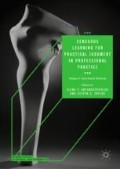Abstract
This Volume has explored the idea of using Sensuous Learning to foster better practical judgement in professional practice. More specifically, it has offered examples of how arts-based methods have been used in advancing new modes of learning.
Access this chapter
Tax calculation will be finalised at checkout
Purchases are for personal use only
References
Antonacopoulou, E. P. (2014). The Experience of Learning in Space and Time. Prometheus, 32(1), 83–91.
Antonacopoulou, E. P. (2018a). Sensuous Learning: What Is It and Why It Matters in Addressing the Ineptitude in Professional Practice. In E. P. Antonacopoulou & S. S. Taylor (Eds.), Sensuous Learning for Practical Judgment in Professional Practice: Volume 1: Arts-Based Methods (Chapter 2). London: Palgrave Macmillan.
Antonacopoulou, E. P. (2018b). Sensuous Learning for Individuals, Communities and Organisations. In E. P. Antonacopoulou & S. S. Taylor (Eds.), Sensuous Learning for Practical Judgment in Professional Practice: Volume 2: Arts-Based Interventions (Chapter 2). London: Palgrave Macmillan.
Bruch, H., & ad Ghoshal, S. (2003). Unleashing Organizational Energy. Sloan Management Review, 44(4), 45–51.
Cole, M., Bruch, H., & Vogel, B. (2012). Energy at Work: A Measurement Validation and Linkage to Unit Effectiveness. Journal of Organizational Behavior, 33, 445–467.
Cross, R., Baker, W., & Parker, A. (2003). What Creates Energy in Organisations? Sloan Management Review, 44(4), 51–56.
Edwards, B. (1979). The New Drawing on the Right Side of the Brain: A Course in Enhancing Creativity and Artistic Confidence. New York: Tarcher.
Essén, A., & Värlander, S. W. (2012). The Mutual Constitution of Sensuous and Discursive Understanding in Scientific Practice: An Autoethnographic Lens on Academic Writing. Management Learning, 44(4), 395–423.
Ladkin, D. (2011). The Art of ‘Perceiving Correctly’: What Artists Can Teach Us About Moral Perception. Tamara Journal for Critical Organization Inquiry, 9(3–4), 91–101.
Panayiotou, A. (2017). Introduction to the Virtual Special Issue on Sensory Knowledge. Management Learning. http://journals.sagepub.com/page/mlq/collections/virtual-special-issues/sensory_knowledge?pbEditor=true. Accessed March 2018.
Springborg, C. (2010). Leadership as Art: Leaders Coming to Their Senses. Leadership, 6(3), 243–258.
Taylor, S. S. (2004). Presentational Form in First Person Research: Off-Line Collaborative Reflection Using Art. Action Research, 2(1), 71–88.
Taylor, S. S. (2014). Silly Social Science Scales: Embracing the Particular. Organizational Aesthetics, 3(1), 4–6.
Taylor, S. S. (2015). Controls and Constraints. Organizational Aesthetics, 4(1), 1–3.
Taylor, S. S. (2016). Seeing More or Seeing Less. Organizational Aesthetics, 5(2), 1–2.
Taylor, S. S. (2017). Seeing Differently: Welcome to My OCD World. Organizational Aesthetics, 6(1), 1–3.
Taylor, S. S., & Statler, M. (2013). Material Matters: Increasing Emotional Engagement in Learning. Journal of Management Education. https://doi.org/1052562913489976.
Tenkasi, R. V., & Hay, G. W. (2004). Actionable Knowledge and Scholar-Practitioners: A Process Model of Theory-Practice Linkages. Systemic Practice and Action Research, 17, 177–206.
Author information
Authors and Affiliations
Corresponding author
Editor information
Editors and Affiliations
Rights and permissions
Copyright information
© 2019 The Author(s)
About this chapter
Cite this chapter
Taylor, S.S., Antonacopoulou, E.P. (2019). Conclusion—Arts-Based Methods for Sensuous Learning: Questions and Quality. In: Antonacopoulou, E., Taylor, S. (eds) Sensuous Learning for Practical Judgment in Professional Practice. Palgrave Studies in Business, Arts and Humanities. Palgrave Macmillan, Cham. https://doi.org/10.1007/978-3-319-98863-4_12
Download citation
DOI: https://doi.org/10.1007/978-3-319-98863-4_12
Published:
Publisher Name: Palgrave Macmillan, Cham
Print ISBN: 978-3-319-98862-7
Online ISBN: 978-3-319-98863-4
eBook Packages: Business and ManagementBusiness and Management (R0)

